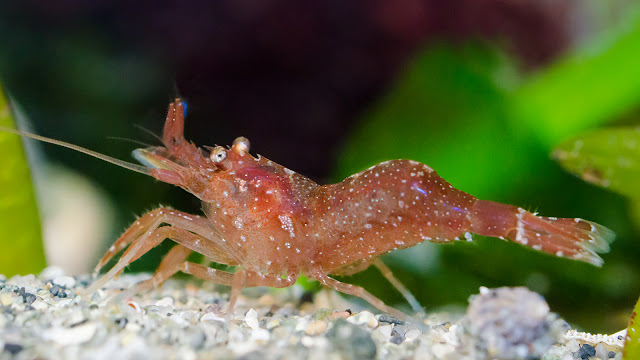 |
| Ma shrimp, in berry, last May. Green, mostly. |
With time, and a good diet, she has turned mostly black, with a white, blotchy saddle. It makes for good camouflage, and poor photos; the camera never knows where to focus.
The other three grew, and started to change colour. One now is a pale bluish pink, one sort of greenish, and the third is a bright red, with white polka dots and blue flags.
 |
| Big Red, resting on sand. |
And this colouring works as camouflage, too; it's rare that I catch this guy against a contrasting background. Here's a photo where I caught him just emerging from his normal hideout:
 |
| Not so easily seen, almost invisible if he's deep in the seaweed. |
These shrimp can take their colouring from their diet; Big Red has been eating dark red bladed algae, and things he finds in the red filamentous algae. But the other three have been living in the same tank, probably eating the same things, and yet they are black, green, and bluish.
I have studied details of the camouflage coloration, in which several patterns occur, all forms of disruptive coloration, in which stripes and splotches break up the outline of the shrimp, making it difficult to recognize when viewed against a background which is variable in color and tone. The disruptive coloration is a defense against visually-hunting predators such as shorebirds and intertidal fishes. ...
Color patterns are poorly expressed in juveniles and small males, rendering them transparent, which is another way to appear invisible to predators using vision. This doesn't work in larger individuals, especially females, since the internal organs and incubated embryos destroy the transparency "trick"; camouflage color patterns then come into play. (From Raymond Bauer, Shrimp researcher.)
Questions, questions. Are the shrimp in the tank choosing different food sources? If I took away the red algae and added only greens, like sea lettuce and rockweed, would Big Red turn green? Where is Ma Shrimp getting her black colouring from? If food was scarcer, would she turn transparent again?
Bauer says that Sitka shrimp lose most of their colouration at night; in a tank, where the lighting is either on or off, the shrimp starts off his day transparent, or nearly so, and 15 minutes after the light is turned on, he's back to normal.
I just went back to my tank; Ma S. is still black, now in the middle of the night. I couldn't find any of the others. But there's still a bit of light, from my screen at the far side of the room. If I work somewhere else, will she disappear?
I'll have to try that.
Two very tiny, completely transparent shrimps hitchiked home with me last week. I can only see them if the light happens to hit them at the right angle, against the right background. I wonder what colour they will turn out to be when they grow up.

Interesting observations. You keep such great photo records as you study your visitors. - Margy
ReplyDelete